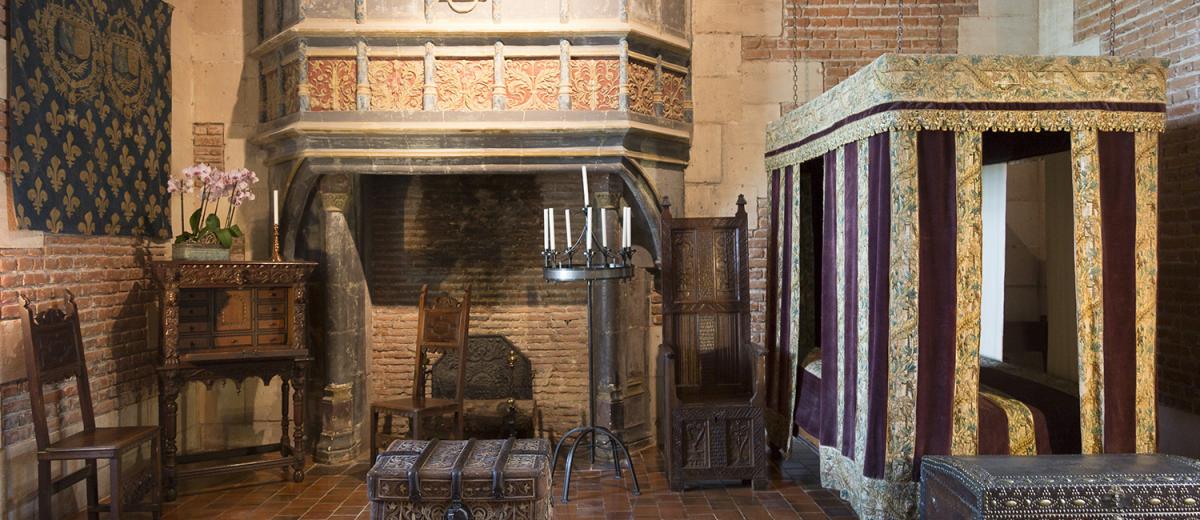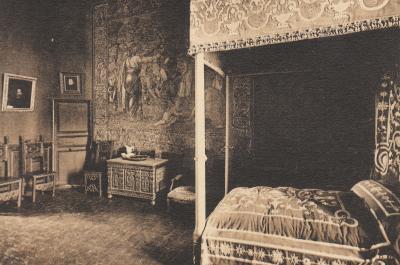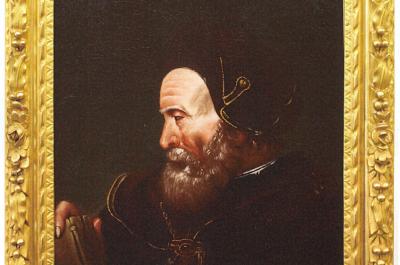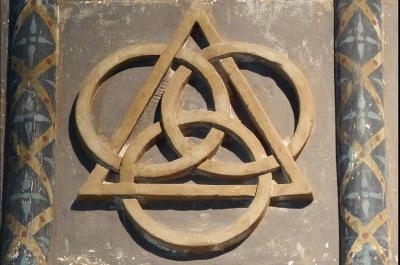This room is named as such because of a symbol on the mantelpiece: the Greek letter delta (the initial of Diane) and three circles or three full moons. This sculpture was initially interpreted as a cabalistic sign of Ruggieri, one of Queen Catherine de Medici’s astrologers, but it could also be an evocation of Diane de Poitiers, since Diane is the moon goddess in Roman mythology.
A late 17th century bed with a suspended canopy, a 17th century portrait presumed to be Cosimo Ruggieri, a curious throne from the 15th century evoking, by means of three different levels, the hierarchical position of the lord and his family or the position of the clergy members and an opening cabinet with a drawer, a belt and a lockable lid from the first quarter of the 17th century complete the furniture in this room.
This room has a polychrome fireplace from the 16th century, which reminds us that all the fireplaces were once painted, and walls built from both brick and stone according to a common technique of the early 16th century.
Cosimo oR Côme Ruggieri
Born in Florence, he was the son of physician, astrologer and soothsayer, Roger the Old (Ruggiero il Vecchio). He was brought to France by Catherine de’ Medici and became her confidant and advisor, exercising considerable influence over her.
A number of predictions have been ascribed to Ruggieri. He is supposed to have told Catherine de’ Medici that she would be crowned Queen of France (when she was married to Henri II, who was only the reigning king’s younger brother at the time) and that she would have 10 children at a time when she believed herself barren.
It was at Château de Chaumont that one of his best known predictions took place: the interview between Ruggieri and Catherine de’ Medici. Historians are not fully in agreement as to which room it took place in, but according to Félibien (a 17th-century French architect and historiographer), the room in question gave onto the Loire, and must therefore have either been in the north wing, which was destroyed in 1750, or the Saint-Nicolas tower, which is still standing.
The story goes that the three faces of Catherine de’ Medici’s sons appeared in succession in a mirror, which turned around as many times as the years each of the three kings would reign: François II (1 turn), Charles IX (14 turns) and Henri III (15 turns). When the latter died childless in 1589, the Valois dynasty gave way to the Bourbons, with the advent of King Henri IV.
Cosimo Ruggieri is also supposed to have predicted to Catherine de’ Medici that she would die “near Saint-Germain”, so causing the construction of the Tuileries Palace to be put on hold as it was located near Saint-Germain-l’Auxerrois Church and motivating her hasty move in 1572 to what was to become the Hôtel de la Reine. The Queen Mother died on 5 January 1589 at Château de Blois. The confessor who was called in to give her the last rites was named Julien de Saint-Germain.
Ruggieri was not only well-versed in astrology, he was also familiar with other magical methods, including reading the future in animal entrails, magic mirrors, and bewitchment by sticking pins in wax figurines.
19th-century authors are largely responsible for his legend, chief among them being Honoré de Balzac with La Confidence des Ruggieri and Le Secret des Ruggieri. These historical novels, belonging to his series of “Philosophical Studies” in which Catherine de’ Medici appears, were the departure point for many and varied writings that shaped the Ruggieri legend, providing the astrologer with a father, “Ruggieri the Old”, and a brother, “Laurent”, even though the existence of these two characters is far from being proven with any certainty.
Gabriel-Louis Pringué, a writer and close friend of the Broglies, was a regular guest at Chaumont. In his book Trente ans de dîners en ville (30 years of dinners in town), he wrote: "I attempted to take by surprise the succession of spirits and spectres escaping from secret staircases. Ruggieri had mixed his poisons there – flasks of which are still locked away in his room – while he read, in the stars, the future of France…"
Model of the East Wing and the Chapel
This model, which is composed of five painted plaster pieces, was created in 1878 at the request of Prince Henri-Amédée de Broglie, by the architect Paul-Ernest Sanson and the sculptor Antoine Margotin, to whom we also owe the dining room’s neo-gothic fireplace.
Prince de Broglie only came to Chaumont on rare occasions to see how the restaurant work was progressing. This model was sent to the de Broglies’ urban mansion at 10 rue de Solférino in Paris, and enabled the Prince to approve or refuse Paul-Ernest Sanson’s architectural proposals.
Sanson planned to restore the galleries on the second floor of the east and west facades, decorating them with scallop motifs retrospectively inspired by the cornices adorning the François I wing at Blois and other buildings in the region (in Beaugency, Orléans, etc.). He also planned to restore the Chapel’s lucarnes and remove its roof crest.



